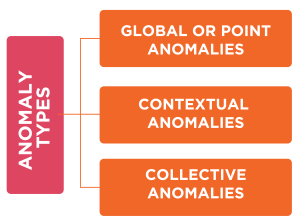Anomaly detection involves identifying data points and patterns deviating from an established hypothesis. This practice, enduring through time, holds vital importance in contemporary contexts. Detecting anomalies is imperative as they often signify crucial information, including a pending or ongoing security breach, hardware or software malfunctions, or shifts in customer demands. These anomalies signal various challenges necessitating immediate attention.
Anomaly detection can be applied to both single-series and multi-series data. Multi-series data comprises multiple independent sequences of events. For instance, in sales data for multiple stores, each store’s sales can be individually analyzed by a single model using the store identifier.
How does Anamoly Detection Work?
Anomaly detection is essential in business settings as it presents accurate and imperative means of detecting unusual cybersecurity and enterprise IT incidents. Utilizing AI models characterizing system behavior and data analytics enables organizations to compare real-world data against predicted values, thus providing critical insights.
When the difference between predicted and actual data measurements exceeds a prescribed threshold, actual data is considered an outlier or anomaly. This identification helps analysts and decision-makers:
- Understand the causes of an anomaly
- Forecast future trends
No model can fully characterize the behavior of complex real-world systems. For example, network traffic to servers is a function of hardware and software systems performance that route global traffic, and the preferences and intents of a heterogeneous set of users.
However, data-driven organizations depend on concrete information from real-world interactions between technologies and end-users. This information, usually collected by monitoring techniques such as synthetic monitoring and real-user monitoring, is used to formulate data models or establish a generally acceptable basis and abide by factors and constraints.
Overcoming Anomaly Detection Challenges
Anomaly detection faces several challenges, such as distinguishing noise from genuine outliers. However, the most complex task is modeling normal behavior to provide the appropriate context for identifying anomalies.
Modeling Normal Behavior
Time series data offers the essential context for normal behavior, critical for detecting anomalies. Without this context, identifying outliers becomes difficult, especially in large, complex systems like environmental trends and traffic fluctuations. Predictive data quality addresses this challenge by facilitating unsupervised anomaly detection at the organizational level. This method involves creating rough statistical models by compressing raw data into significantly smaller chunks, allowing for benchmarking and baselining datasets over time.
Additionally, approved variance in modeling normal behavior enhances the precision of anomaly detection.
Noise and Poor Data Quality
In specific use cases, such as healthcare, the detection rules for outliers are stringent, and even minor changes can be critical. Therefore, managing noise and ensuring high data quality is vital for distinguishing outliers from normal records. Failing to do so can undermine the effectiveness of anomaly detection.
Streaming Data Volume
Large volumes of streaming data can impact system processing speeds. Scalable predictive data quality solutions help detect drifts and outliers in real-time, providing early warnings through machine learning-based algorithms.
In-Depth Data Understanding
Some datasets include specific values not intended for outlier detection or data quality assessments. Understanding these extreme values can be challenging, as time-series context alone is often insufficient. Data intelligence aids in accurately comprehending and utilizing enterprise-level data. By connecting insights, data, and algorithms, businesses can thoroughly understand their data, enabling more accurate identification of anomalies.
Types of Anomalies
 Global Anomalies (Point Anomalies)
Global Anomalies (Point Anomalies)
A global anomaly is a data point that is significantly higher or lower than the average. For instance, if the average credit card bill is $2,000, a bill of $10,000 would be considered a global anomaly.
Contextual Anomalies
Contextual anomalies depend on the specific context in which they occur. For example, credit card bills may vary seasonally, such as higher spending during holidays. While these spikes might appear anomalous when viewed in aggregate, they are expected within the seasonal context.
Collective Anomalies
Collective anomalies refer to a set of data points that, when considered individually, may not appear unusual but collectively indicate an anomaly over time. For example, a credit card bill increasing from $2,000 to $3,000 for one month might not raise concern. However, if it stays at $3,000 for several months, it becomes a detectable anomaly. These are often identified using “rolling average” data, which smooths out a time series to highlight trends and patterns.
#6 Cynet
Cynet is a leader in advanced threat detection and response solutions. Our company streamlines security measures by offering a swiftly deployable, all-encompassing platform. This platform enables detection, prevention, and automated response to advanced threats with minimal false positives, significantly reducing the time taken from detection to resolution and mitigating organizational damage.
With Cynet’s unparalleled visibility into files, users, network traffic, and endpoints, coupled with continuous environment monitoring, we uncover behavioral and interaction indicators throughout the attack chain. This approach provides a holistic view of attack operations over time, empowering organizations with comprehensive threat intelligence.
#7 Microsoft Azure
Microsoft Azure, a leader in cloud computing solutions, provides an AI-driven Anomaly Detector tool renowned for its excellence in real-time anomaly detection. Tailored for finance, e-commerce, and Internet of Things (IoT) applications, this tool swiftly identifies anomalies, addressing the urgent demand for rapid detection in critical scenarios.
#8 IBM Z Anamoly Analytics
IBM Z Anomaly Analytics is sophisticated software designed to offer intelligent anomaly detection and allow proactive identification of operational issues within your enterprise environment.
Utilizing historical IBM Z log and metric data, IBM Z Anomaly Analytics constructs a model of normal operational behavior. Subsequently, real-time data is assessed against this model to detect and notify IT operations of any abnormal behavior promptly.
Features:
- Machine learning system based on metrics: Identify anomalies in metric data retrieved from z/OS System Management Facilities (SMF) record types, as well as in log data from IBM IMS log record types.
- Integrated log anomaly detection: Deviation in message frequency, occurrence, or sequence patterns within logs indicates anomalies.
- Topology service and hybrid correlation: By consuming IBM Z events and topology for Watson AIOps, IBM Cloud Pak correlates them with events from the entire enterprise. This enables users to promptly determine the impact of incidents and identify the root cause of operational issues across their hybrid applications.
#9 Amazon Sagemaker
Amazon SageMaker Random Cut Forest (RCF) is a powerful unsupervised algorithm designed for detecting anomalous data points within datasets. These anomalies represent observations that deviate from the otherwise well-structured or patterned data. Anomalies may present themselves as unexpected spikes in time series data, disruptions in periodicity, or data points that defy classification. When visualized on a plot, anomalies are readily distinguishable from the “regular” data.
Incorporating these anomalies into a dataset can significantly elevate the complexity of a machine-learning task. The “regular” data can often be adequately described using a simple model. As a result, including anomalies necessitates more sophisticated modeling techniques to capture the underlying patterns and relationships within the data effectively.
#10 Elastic X-Pack
Elastic X-Pack is a comprehensive package designed to streamline the management and security of data within Elasticsearch and Kibana. With X-Pack, users can effortlessly secure Elasticsearch data and implement features like a login screen via Kibana, all within a single installation.
X-Pack is readily available on Elastic Cloud, enabling users to deploy the latest versions of Elasticsearch and Kibana alongside X-Pack features developed by the creators of the Elastic Stack. Its robust security features ensure that the right individuals have appropriate access to data, safeguarding against unauthorized access and malicious activity.
Finally
In conclusion, anomaly detection entails establishing normal behavior, constructing a model to encapsulate this behavior, and determining thresholds for identifying significant deviations from the norm. However, it’s essential to recognize that anomaly detection is just one facet of comprehensive data governance. Strengthening anomaly detection algorithms and improving data quality initiatives necessitates the development of a robust data governance program. By prioritizing data governance, organizations can enhance anomaly detection capabilities and ensure the integrity of their data.
FAQs
1. How can organizations implement anomaly detection effectively?
Effective implementation of anomaly detection involves understanding the specific requirements and challenges of the organization, selecting appropriate techniques and algorithms, collecting and preprocessing data, training and fine-tuning models, integrating anomaly detection into existing systems, and continuously monitoring and evaluating performance.
2. What role does machine learning play in anomaly detection?
Machine learning techniques, such as clustering, classification, and time series analysis, are commonly used in anomaly detection to identify patterns or anomalies in data. These techniques enable organizations to detect and respond to anomalies more accurately and efficiently than traditional rule-based approaches.
3. How does anomaly detection differ from traditional monitoring or threshold-based alerting?
Unlike traditional monitoring or threshold-based alerting, which rely on predefined thresholds to trigger alerts, anomaly detection algorithms can detect subtle deviations from normal behavior without the need for explicit rules or thresholds. This enables organizations to identify unknown or unexpected anomalies more effectively.
4. What are the key considerations for implementing anomaly detection in healthcare monitoring systems?
Key considerations for implementing anomaly detection in healthcare monitoring systems include data privacy and security, regulatory compliance, interoperability with existing systems, and scalability to handle large volumes of patient data.
[To share your insights with us as part of editorial or sponsored content, please write to sghosh@martechseries.com]


